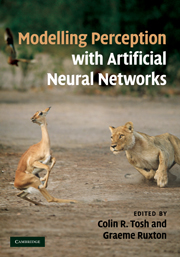Book contents
- Frontmatter
- Contents
- Contributors
- Introduction: Modelling perception with artificial neural networks
- Part I General themes
- Part II The use of artificial neural networks to elucidate the nature of perceptual processes in animals
- 3 Correlation versus gradient type motion detectors: the pros and cons
- 4 Spatial constancy and the brain: insights from neural networks
- 5 The interplay of Pavlovian and instrumental processes in devaluation experiments: a computational embodied neuroscience model tested with a simulated rat
- 6 Evolution, (sequential) learning and generalisation in modular and nonmodular visual neural networks
- 7 Effects of network structure on associative memory
- 8 Neural networks and neuro-oncology: the complex interplay between brain tumour, epilepsy and cognition
- Part III Artificial neural networks as models of perceptual processing in ecology and evolutionary biology
- Part IV Methodological issues in the use of simple feedforward networks
- Index
- References
8 - Neural networks and neuro-oncology: the complex interplay between brain tumour, epilepsy and cognition
from Part II - The use of artificial neural networks to elucidate the nature of perceptual processes in animals
Published online by Cambridge University Press: 05 July 2011
- Frontmatter
- Contents
- Contributors
- Introduction: Modelling perception with artificial neural networks
- Part I General themes
- Part II The use of artificial neural networks to elucidate the nature of perceptual processes in animals
- 3 Correlation versus gradient type motion detectors: the pros and cons
- 4 Spatial constancy and the brain: insights from neural networks
- 5 The interplay of Pavlovian and instrumental processes in devaluation experiments: a computational embodied neuroscience model tested with a simulated rat
- 6 Evolution, (sequential) learning and generalisation in modular and nonmodular visual neural networks
- 7 Effects of network structure on associative memory
- 8 Neural networks and neuro-oncology: the complex interplay between brain tumour, epilepsy and cognition
- Part III Artificial neural networks as models of perceptual processing in ecology and evolutionary biology
- Part IV Methodological issues in the use of simple feedforward networks
- Index
- References
Summary
Introduction
The human brain is by far the most complex network known to man. Neuroscience has for a long time focused on a reductionistic approach when studying the brain, in part precisely because of its daunting complexity. Although highly important insights have been obtained by using a localisational method, this type of research has failed to elucidate the elaborate mechanisms involved in higher brain functioning and perception. As a consequence, an increasing body of research regarding the brain's functional status has become founded on modern network theory. In this subdivision of mathematics and physics, emphasis is placed on the manner in which several parts of the brain interact, instead of on which specific part of the cortex is responsible for a certain task. The first studies using networks to investigate the brain have made use of computational models and animal studies. Due to the great research advances in recent years, network theory is now being readily applied to the human brain. Studies are being performed in both the healthy population and several patient groups, in order to find out what constitutes a healthy versus a diseased brain (for an introduction into brain networks, see Watts & Strogatz, 1998; Bassett & Bullmore, 2006; Reijneveld et al., 2007).
Brain tumours almost invariably cause highly burdensome symptoms, such as cognitive deficits and epileptic seizures. The tumour has significant impact on the brain, since it forces the non-tumoural tissue to adapt to the presence and constant expansion of a foreign entity.
Information
- Type
- Chapter
- Information
- Modelling Perception with Artificial Neural Networks , pp. 149 - 184Publisher: Cambridge University PressPrint publication year: 2010
References
Accessibility standard: Unknown
Why this information is here
This section outlines the accessibility features of this content - including support for screen readers, full keyboard navigation and high-contrast display options. This may not be relevant for you.Accessibility Information
- 1
- Cited by
